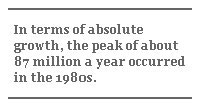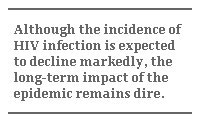Coping with World Population Boom and Bust – Part I
Coping with World Population Boom and Bust – Part I

NEW YORK: One of the defining features of the 20th century that changed the course of all life and the natural environment on this planet was the unprecedented rise in world population. Incredibly, over the past 100 years the world's total population nearly quadrupled – from 1.6 billion to 6.1 billion, with most of this growth occurring during the last 50 years. In addition, the 20th century ushered in revolutionary changes in life expectancy, fertility, population aging, and large-scale migration.
What kind of future will the 21st century bring? Demographers paint a complex picture of many contradictory trends. Of the projected major trends identified by the United Nations, one of the more politically sensitive is that population growth will be the fastest in poor countries, leading to a spurt in migration towards developed countries. An expected rapid rise in the world’s urban population also holds heavy consequences.

Although experts debate over the exact numbers, the one trend on which all population forecasters agree is that the world's population will continue to grow in the 21st century. At least 2 billion additional inhabitants, and perhaps closer to 3 billion, are expected to be added to the world over the next five decades. This projected increase would put the total at 9 billion by 2050. It would also be the second highest half-century increase in recorded human history, just under the 3.5 billion between 1950 and 2000.
But the pace of the world population growth will slow down. In terms of absolute growth, the peak of about 87 million a year occurred in the late 1980s. The current annual increase of world population is about 77 million people. By mid-century the world is expected to be adding 29 million annually. The primary reason for the slowdown is declining fertility rates, especially among the less developed regions of the world.

However, more of the world’s population will be concentrated in less developed countries. By 2050, nearly 90 percent of the world’s population is expected to be living in less developed nations versus 80 percent today. This is simply due to the fact that nearly all of the world’s future population growth will be taking place in the less developed regions. Today, six countries account for half of the world’s annual growth of 77 million: India, China, Pakistan, Nigeria, Bangladesh and Indonesia. India alone accounts for about a fifth of the world’s total population growth.
As a result of the considerable differences in population growth rates among countries and regions, the redistribution of the world’s population is well underway. This redistribution is bringing about a new international population order. Consider, for example, the case of Europe. In 1950, the population of Europe accounted for about 22 percent of world population; today it represents close to half that level, 12 percent; and by 2050, Europe’s population is expected to be about 7 percent of the world. Another example is a comparison of Pakistan and the Russian Federation. In 1950, the population of the Russian Federation was more than double the size of Pakistan’s population (103 million versus 40 million); today, they are roughly the same size, with the Russian Federation at 143 million and Pakistan at 157 million. By mid-century, however, Pakistan’s population is expected to be triple the size of the Russian Federation’s population (349 million versus 101 million).

A natural corollary of this population growth in the less developed countries, demographers say, would be a rise in migration. At the beginning of the 20th century, roughly 33 million people were living outside the country of their birth. Today the number is estimated to be 175 million, with about 60 percent residing in Europe and North America. International migration flows are expected to remain high during the 21st century. The more developed regions are expected to continue being net receivers of international migration, with an average gain of at least 2 million per year over the coming half century. Most migrants to Europe are expected to come from Africa and Asia; in Northern America, the bulk is expected to come from Central and South America.
Fertility levels will also be lower in the 21st century, especially among less developed regions. Whereas in the 1950s, women in less developed regions had an average of six children, today‘s average is closer to three. By mid-century, the global fertility average is anticipated to be close to replacement levels of around two children per couple.

The impact of the HIV/AIDS epidemic is also expected to worsen. For at least the next few decades, the epidemic will lead to increased morbidity, mortality, and population loss for the currently most affected countries. Although the probability of HIV infection is expected to decline markedly in the future, the long-term impact of the epidemic remains dire.
Only a few years into the new millennium, most of the world’s population growth is taking place in urban areas of the less developed regions. Within the next few years, the majority of the world will no longer be rural dwellers, but rather live in cities. Over the next three decades, urban areas in less developed regions are expected to double in size, growing from 2 billion today to 4 billion by 2030. A great deal of this rural-to-urban migration will be to the largest cities of the less developed countries, increasing demands for employment and social services, most notably public health care systems.

In the midst of this great migration and population growth, the world's population will also grow older, and people will live longer. Modern medicine, lifestyle changes, and improved nutrition should lead to lower mortality rates and longer life spans. By mid-century, global life expectancy is projected to be about 75 years of age – 10 years more than today. The percent of people 65 years or older is expected to more than double over the next five decades, increasing from 7 percent to 16 percent.
Among other things, population aging raises serious questions about the financial viability of pension and health care systems for the elderly. With the number of workers declining relative to those in the retirement ages, many anticipate the arrival of a “red-ink society”. Today’s budgets for social security, pensions, and health care are in the black, largely as a result of the favorable demographics of the past. However, with changing demographics, many fear not only that the red ink is coming soon, but that the stain extends as far as the eye can see.
Preventing this trend is a major economic challenge facing governments in many developed and developing countries. Possible responses include raising the age at retirement, reducing old-age benefits and health care coverage, and raising taxes. None of these responses, however, are popular among elected officials or the general public. Of course, there are some who believe that no response is required and that with time the red ink will simply go away. To this, one cynic retorted: “I have all the money that I will ever need… as long as I die by 4 pm this afternoon.”
Joseph Chamie is the Director of the Population Division, Department of Economic and Social Affairs, United Nations. The views expressed in this paper are those of the author and do not necessarily reflect those of the United Nations.